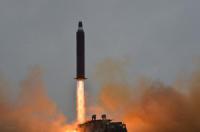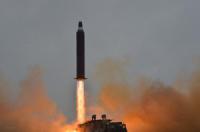-
A single nuke's impact should be measured by more than megatons
As the notion of nuclear hostilities leaps from its old, Cold War perch into modern debate, new calculations by researchers show that even a limited nuclear strike could have disastrous global consequences. The researchers have determined that a single nuclear warhead could cause devastating climate change resulting in widespread drought and famine that could cost a billion lives.
-
-
German intelligence: Iran still seeking illicit nuclear technology
Reports from German intelligence agencies show that Iran is still attempt to procure illicit technology, including parts for the operation of its heavy water reactor, which was shuttered under the terms of the 2015 nuclear deal. Three German citizens were charged with violating export bans for sending 51 specialized valves to Iran. The parts can be used in Iran’s Arak heavy water reactor, which “can be used to develop plutonium for nuclear weapons” and was shut down as part of the nuclear deal.
-
-
New technique detects radioactive material even after it is gone
A new technique allows researchers to characterize nuclear material that was in a location even after the nuclear material has been removed – a finding that has significant implications for nuclear nonproliferation and security applications. The technique could identify and characterize a dirty bomb based on samples taken from a room the bomb was in a year ago. “This is a valuable tool for emergency responders, nuclear nonproliferation authorities and forensics, because it allows us to get a rough snapshot of the size of a radiation source, where it was located, how radioactive it is, and what type of radioactive material it is,” a researcher says.
-
-
Scintillating discovery at Sandia Labs
Taking inspiration from an unusual source, a Sandia National Laboratories team has dramatically improved the science of scintillators — objects that detect nuclear threats. According to the team, using organic glass scintillators could soon make it even harder to smuggle nuclear materials through America’s ports and borders. The Sandia Labs team developed a scintillator made of an organic glass which is more effective than the best-known nuclear threat detection material while being much easier and cheaper to produce.
-
-
Remote detection of hazardous radioactive substances
Remote detection of radioactive materials is impossible when the measurement location is far from its source. A typical radiation detectors, like Geiger-Muller counters can detect 1 milli Curie (mCi) of Cobalt-60 (60Co) at a maximum distance of 3.5 meters, but are inefficient at measuring lower levels of radioactivity or at longer distances. Researchers have developed a method for the remote detection of hazardous radioactive substances. With the help of this newly developed detection device, the detection of various types of radioactive materials can be done from a remote distance.
-
-
Overcoming the trust barrier in nuclear weapons verification measurements
Trust but verify. The catchphrase for arms control popularized by President Ronald Reagan sounds simple. However, verification involving sensitive data is a very complex endeavor. Verifying that a nuclear warhead actually is a warhead may include confirming key attributes. But the act of confirming certain technical attributes might reveal critical design information — closely guarded national secrets for any country. Confirming these attributes will likely require overcoming the hurdle of protecting sensitive design data. Sandia National Laboratories physicist Peter Marleau has developed a new method for verifying warhead attributes.
-
-
Why there’s no modern guide to surviving a nuclear war
The risk of thermonuclear war has rarely been greater. But despite the growing threat, the general public are less prepared than they ever have been to cope with an attack. Time is short – but the United Kingdom is not ready. In May 1980, the government created a series of public information films, radio broadcasts, and the booklet Protect and Survive. But the effort was mocked, and the government abandoned to effort. The failure of Protect and Survive is the reason the United Kingdom doesn’t have public information on how to prepare for a nuclear war today. There are good reasons for keeping us unaware. Releasing guidance may cause anxiety and even make other countries suspicious that our preparations are a sign that we intend to strike first. On the other hand, if the government does intend to issue information at the last minute then it is taking a huge risk as to whether it can get the advice out in time. If an accidental launch, or an unexpected first strike, occurs then there may be no time. Maybe now is the right time to buy that reprinted copy of Protect and Survive – just in case.
-
-
Hackers could take control of missiles on U.K. subs, start a “catastrophic” nuclear war: Report
Britain’s Trident nuclear weapons deterrent program consists of four Vanguard-class submarines, each carrying up to sixteen Trident II D5 ballistic missiles with a nuclear warhead. Hackers could take control of nuclear weapons-carrying Vanguard-class submarines and start a “catastrophic” nuclear war, a new report warns. The 38-page report warns a security breach could “neutralize operations, lead to loss of life, defeat or perhaps even the catastrophic exchange of nuclear warheads (directly or indirectly).” Des Browne, former U.K. Defense Secretary, said: “To imagine that critical digital systems at the heart of nuclear weapon systems are somehow immune or can be confidently protected by dedicated teams of network managers is to be irresponsibly complacent.”
-
-
$2-million grant for training next generation of nuclear arms control experts
Post-Cold War arsenal reductions by the United States and Russia have slowed, and both sides continue to keep many hundreds of weapons on hair trigger alert ready to launch within minutes of a country’s leader pushing the button. Meanwhile, concerns grow about nuclear programs in North Korea, South Asia, and the Middle East. Princeton University’s Program on Science and Global Security (SGS) has received a $2-million grant from the MacArthur Foundation. The award will support SGS’ efforts to educate and train the next generation of researchers and scientists studying nuclear non-proliferation, arms control and disarmament.
-
-
NK, currently with 13-30 nukes, is expanding its arsenal by 3-5 weapons per year

As of the end of 2016, North Korea is estimated to have 33 kilograms of separated plutonium and between 175 and 645 kilograms of weapon-grade uranium. If North Korea would use 70 percent of its estimated stock of weapon-grade uranium and plutonium to produce nuclear weapons, it would have between 13 and 30 such weapons, depending on their yield. David Albright of the Institute for Science and International Security says that based on this cumulative estimate, North Korea is currently expanding its nuclear weapons at a rate of about 3-5 weapons per year.
-
-
Drop of mock nuclear weapon by Sandia Lab is first of new flight tests
Sandia’s B61-12 weapon refurbishment program consolidates and replaces four B61 variants in the nation’s nuclear arsenal. The first production unit in the weapon’s life extension program is scheduled to be completed in 2020. From a distance, the 14 March drop of a mock nuclear weapon — containing only non-nuclear components — was a mere puff of dust rising from a dry lake bed at Nevada’s Tonopah Test Range. However, it marked the start of a new series of test flights vital to the nation’s B61-12 program.
-
-
Nuclear expert: “Real risk” that Iran and N. Korea cooperating on nuclear matters
There is a “real risk” that Iran and North Korea are engaged in illicit nuclear cooperation, a former United Nations weapons inspector and nuclear non-proliferation expert said. David Albright, president of the Institute for Science and International Security, called on the Trump administration to investigate any potential nuclear collaboration between the two nations.
-
-
The hollow threat of nukes
As President Trump signals that he wants to expand the nation’s nuclear arsenal, two experts say said nuclear weapons deter aggression, but that there is no evidence to support the common view that they are also useful as a coercive tool against adversaries. “[B]efore we spend $1 trillion buying new and more capable nuclear weapons, it’s worth taking a step back and asking, what is all of that money bringing us?” they said.
-
-
Missiles tested by North Korean this weekend capable of carrying 500 kg warhead to 1,000 km

Over the weekend, North Korea launched four ballistic missiles into the Sea of Japan. The missiles reportedly traveled an average of 1,000 km (620 miles), and landed within 300 to 350 km (185 to 220 miles) of Japan. The four launches were said to be “simultaneous,” leading to speculation they were intended to be a barrage attack to overwhelm a missile defense system. The missiles appear to be Extended-Range Scud (“Scud ER”) missiles, which are modifications of short-range Scud missiles, lengthened to carry additional fuel and lightened by making the body out of aluminum rather than the usual steel. Analysis suggests the missile could carry a warhead of roughly 500 kg to 1,000 km.
-
-
Preventing nuclear waste seepage
Nuclear waste is a reality, whether remnants of nuclear weapons or the byproducts of nuclear power plants. While we aren’t at risk of an attack from a giant radioactive lizard, nuclear waste can still pose threats to human health. The best way to safely store and contain nuclear waste is by mixing it into a cement grout and storing it in large concrete vaults. Researchers are testing the permeability of these grout mixtures and in turn, the ability for nuclear materials to eventually flow through the solidified grout and into the environment.
-
- All
- Regional
- Water
- Biometrics
- Borders/Immig
- Business
- Cybersecurity
- Detection
- Disasters
- Government
- Infrastructure
- International
- Public health
- Public Safety
- Communication interoperabillity
- Emergency services
- Emergency medical services
- Fire
- First response
- IEDs
- Law Enforcement
- Law Enforcement Technology
- Military technology
- Nonlethal weapons
- Nuclear weapons
- Personal protection equipment
- Police
- Notification /alert systems
- Situational awareness
- Weapons systems
- Sci-Tech
- Sector Reports
- Surveillance
- Transportation
Advertising & Marketing: advertise@newswirepubs.com
Editorial: editor@newswirepubs.com
General: info@newswirepubs.com
2010-2011 © News Wire Publications, LLC News Wire Publications, LLC
220 Old Country Road | Suite 200 | Mineola | New York | 11501
Permissions and Policies
Editorial: editor@newswirepubs.com
General: info@newswirepubs.com
2010-2011 © News Wire Publications, LLC News Wire Publications, LLC
220 Old Country Road | Suite 200 | Mineola | New York | 11501
Permissions and Policies
